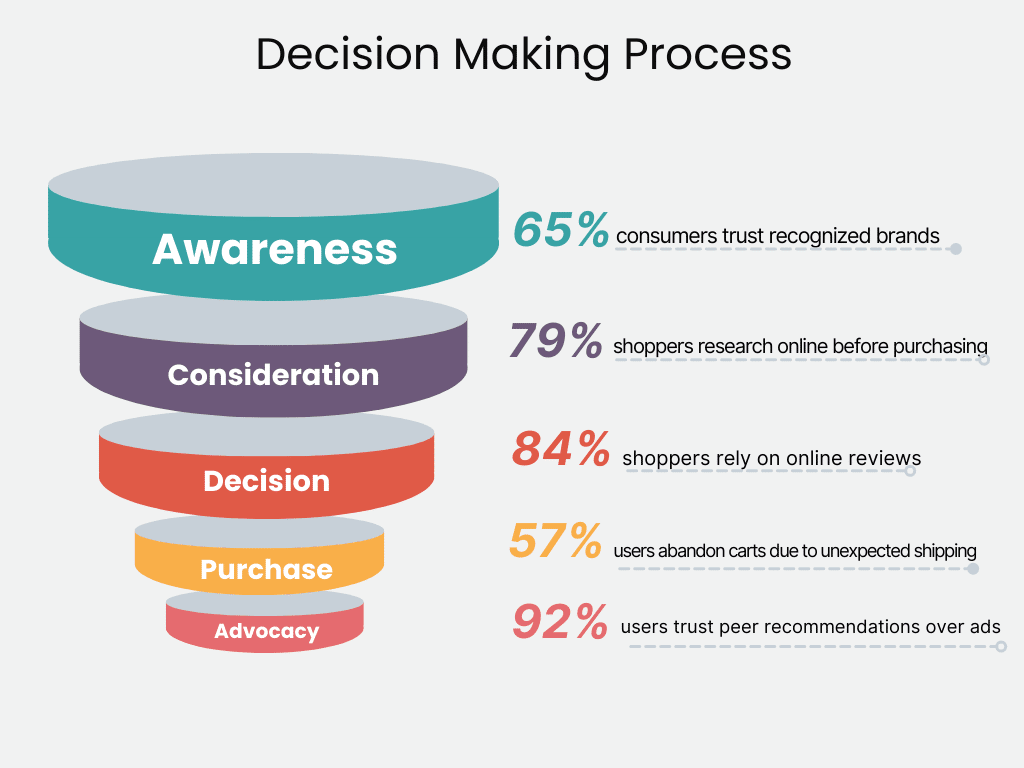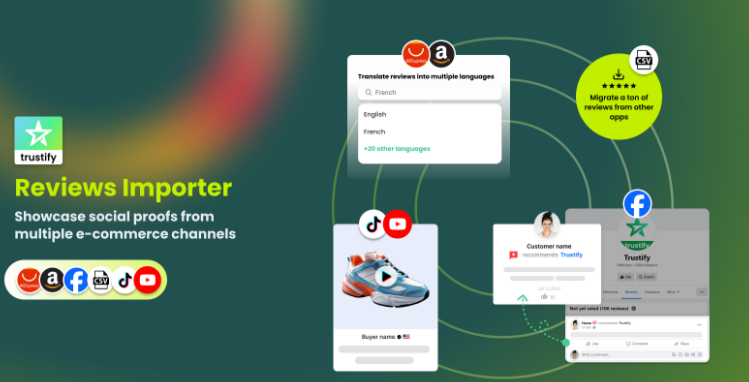What motivates customers to choose a specific product or service? Merchants can investigate this by examining the different stages a customer experiences during the purchase decision process, beginning with acknowledging a need.
Utilize the consumer decision-making process to gain insights into how customers make purchase decisions and how you can guide them toward purchasing.
What is The Consumer Decision-Making Process?
The consumer decision-making process consists of several stages that individuals experience when acquiring a product or service. This starts when a customer identifies a need or problem, searches for solutions, compares options, and makes a final purchase decision. Brands utilize effective tools and marketing strategies to simplify their purchasing process and shape consumer behavior.

Some Factors that Influence Consumer Decision-Making
Consumer decision-making is shaped by various factors that affect how we assess, choose, and purchase products or services.
Understanding these factors is essential for marketers to effectively reach their audience and develop strategies that align with consumer needs and desires.
Obtaining insights into consumer behavior is vital for marketers to comprehend these influencing factors and adjust their strategies accordingly.
External Factors
- Social Proof: Reviews, ratings, and testimonials from other customers can heavily influence the consumer decision-making process.
- Brand Reputation: Established brands with positive reputations tend to attract more consumers.
- Price and Promotions: Discounts, deals, and perceived value play a significant role in decision-making.
- Website Design and Usability: A user-friendly, aesthetically pleasing website enhances trust and encourages purchases.
- Marketing and Advertising: Targeted ads, social media presence, and email marketing can impact consumer awareness and interest.
Internal Factors
- Personal Preferences: Individual tastes and preferences shape product choices.
- Emotional State: Feelings such as happiness, frustration, or excitement can influence purchasing behavior.
- Motivation: The underlying reasons for a purchase, such as necessity or desire for status, affect decisions.
- Cognitive Dissonance: Consumers may seek justification for their choices to avoid regret, influencing their final decision.
Additional Factors
- Cultural Influences: Cultural background and societal norms can affect product perception and acceptance.
- Trust and Security: Concerns about online security and data privacy can impact willingness to purchase. So, your store should use trust badges to boost trust and conversion rates
- Convenience: Ease of access and shopping experience, including payment options and delivery, can sway the consumer decision-making process.
5 Stages of The Consumer Decision-Making Process
The consumer decision-making process consists of a sequence of steps that customers follow when making a purchase.
Although the specifics can differ among individuals, the fundamental stages of the final purchasing decision are quite similar.
Mapping the customer journey can assist businesses in visualizing and comprehending the various stages consumers experience, from recognizing their needs to evaluating their purchases afterward.
Let’s explore these consumer decision-making processes 5 steps:
Stage 1: Need/ Problem Recognition
The process begins with recognizing a need. This is the initial awareness of a problem, desire, or opportunity that a product or service can address.
Triggers such as life changes or marketing efforts can prompt this recognition.
Recognition can stem from:
- Internal stimuli: Personal needs, desires, or shifts in circumstances (e.g., starting a new job or expanding a family).
- External stimuli: Marketing messages, recommendations from others, or situational influences (e.g., promotional sales or new product releases).
Understanding what drives your target audience’s needs and wants is vital for effective marketing. By grasping these motivations, you can customize your messaging and offerings accordingly.
Stage 2: Information Search
Once a need is identified, customers typically turn to physical locations or search engines for information about possible solutions. This search can involve:
- Internal sources: Previous experiences or acquired knowledge.
- External sources: Online research, customer reviews, recommendations from friends and family, or consultations with experts.
For example, someone in search of a new camera might look up terms like “best cameras 2020,” “affordable camera,” or “top-rated cameras”.
Given the overwhelming amount of information available, consumers may face information overload, complicating their decision-making process.
The extent of a consumer’s search is influenced by their prior knowledge and the number of options available. A person buying a camera as a gift will likely require more information than someone who already knows what they want.
To enhance your online business during this stage, ensure you are visible in search results and that your content resonates with potential customers.
Here are some strategies to optimize your business during the research phase:
- SEO Optimization
- Identify the keywords that are likely to be used in the consumer decision-making process.
- Grasping search engine algorithms is essential for optimizing your website’s content and increasing its visibility.
- Ensure that your website’s content, headings, meta descriptions, and images are optimized with relevant keywords.
- Maintain a technically sound and search-friendly website.
- User-Generated Content
- Encourage reviews on your website and platforms like Google Reviews.
- Online reviews serve as a powerful form of user-generated content that can sway potential customers.
- Motivate customers to share their experiences on social media.
- Utilize Google-rich snippets to display product ratings and reviews in search results.
- Product Listing Ads
- Design product listing ads that showcase key features and benefits.
- Use high-quality images to present your products.
- Adjust your bids to ensure your ads appear in search results.
Thanks to the internet and social media, information is more accessible than ever, giving customers more resources to make informed purchasing decisions. Effective ad targeting ensures that your product listing ads reach the appropriate audience, enhancing conversion potential.
Stage 3: Evaluation of Options
Armed with information, customers can assess their purchase options. This evaluation involves comparing various products or services based on:
- Price: Conducting a cost-benefit analysis.
- Features: Examining functionality and attributes.
- Quality: Considering durability and performance.
- Brand: Assessing reputation and image.
- Availability: Evaluating accessibility and convenience.
Comparison shopping enables consumers to weigh different products or services against these criteria, with specific factors varying by individual customer and type of purchase.
Stage 4: Buying Decision
After thorough evaluation and comparison, the customer reaches a buying decision.
This stage includes selecting a specific product, brand, or retailer and determining the timing and method of purchase (e.g., online or in-store).
Purchase intent is crucial here, as it influences whether the consumer will complete the transaction.
Factors that may affect the buying decision include:
- Promotions: Discounts, coupons, or special offers.
- Availability: Is the product in stock?
- Sales Interactions: How well did the interaction with the salesperson go?
- Risk Perception: What risks does the customer perceive with the purchase?
Stage 5: Post-Purchase Evaluation
The final phase of the consumer decision-making process involves post-purchase evaluation.
In this stage, the customer assesses their satisfaction with the purchase and whether it meets their expectations.
Feedback during this phase is crucial for businesses to gauge customer satisfaction and identify areas for improvement.
If a product or service surpasses expectations, the customer is likely to be satisfied and make future purchases. Conversely, if it falls short, they may feel dissatisfied or regretful.
With an understanding of these five stages, you can enhance your marketing efforts. By recognizing what customers need and do at each point in their journey, you can improve your messaging, offerings, and overall service.
Unique Strategies for Optimizing the Consumer Decision-Making Process
Leverage Social Proof
Utilize social proof to enhance the credibility of your products or services and foster trust with prospective customers. Gather and display user-generated content, including reviews, testimonials, and social media interactions.
Tools like Trustify can aid in establishing trust and credibility, which allows you to showcase authentic customer reviews directly on your website. By displaying verified user testimonials, especially at crucial touchpoints like product pages or checkout, you reduce uncertainty and increase buyer confidence. Featuring user-generated content (UGC), ratings, and video testimonials from satisfied customers can help potential buyers feel more secure in their decisions.

Understand Your Audience
Grasping your audience is essential for optimizing your marketing strategies.
Market segmentation enables businesses to categorize their audience into specific groups based on demographics, behaviors, and preferences.
Evaluate your competitors’ customer bases and perform market research through surveys or focus groups to understand their interests, needs, and challenges. This insight will help you tailor messages that resonate with your target demographic.
Develop a Strong Brand
A robust brand can significantly sway consumer choices. To foster brand loyalty and encourage repeat business, dedicate time, resources, and effort to nurturing loyal brand advocates who enhance the customer experience throughout the purchasing journey.
Creating substantial brand equity involves cultivating a positive perception of your brand, which can lead to increased customer loyalty and higher sales. To strengthen your brand, develop valuable brand assets, define brand guidelines, and maintain consistency across all customer interactions.
Optimize Your E-commerce Store
To encourage purchases, ensure your online shopping experience is smooth and user-friendly.
A seamless user experience navigates customers through the buying process and helps ensure they complete their transactions.
Utilize high-quality product images, clear calls to action, and mobile-responsive designs to facilitate purchases. Consider platforms like Shopify, which offer secure checkout options, customizable themes, and automated email sequences to streamline the consumer buying journey.

Select the Right Pricing Strategy
An appropriately chosen pricing strategy can greatly influence consumer behavior and sales. When determining a pricing model, take into account production costs, profit margins, market demand, competitor pricing, and revenue objectives.
Understanding price sensitivity enables businesses to set prices that maximize sales while aligning with consumer expectations.
Be transparent and provide a clear breakdown of the total cost upfront, including taxes, shipping, and any additional fees. Avoid revealing the total price only at the final purchase stage, as this could harm your reputation and lead to cart abandonment.
By implementing these strategies, businesses can effectively influence consumer purchasing decisions and enhance their chances of converting potential customers into loyal buyers.
FAQs About Consumer Decision-Making Process
1. How do consumers evaluate options?
Consumers evaluate options by comparing products based on various criteria such as price, features, quality, and brand reputation. This evaluation helps them identify which product best meets their needs and preferences.
2. What are the common pitfalls brands face in influencing consumer decisions?
Brands often fall into the trap of focusing too much on features rather than addressing consumer needs and emotions. They might also neglect the importance of storytelling and authenticity, leading to a disconnect with consumers. To avoid these pitfalls, brands should invest in understanding their audience and crafting meaningful narratives that resonate.
3. What is the most important stage of the consumer decision-making process?
All five stages of the consumer decision-making process hold significance, but the initial stage is especially crucial because it marks the beginning of final purchase decisions, with customers acknowledging a need to satisfy or a problem to address.
WRAP UP
The consumer decision-making process is a complex process influenced by various factors, including individual needs, preferences, perceptions, and external influences. Understanding consumer behavior is crucial for businesses to develop effective marketing strategies and create products that resonate with their target audience.
By studying the consumer decision-making process through this article, businesses can gain valuable insights into how consumers perceive and evaluate products, ultimately leading to increased sales and customer satisfaction.